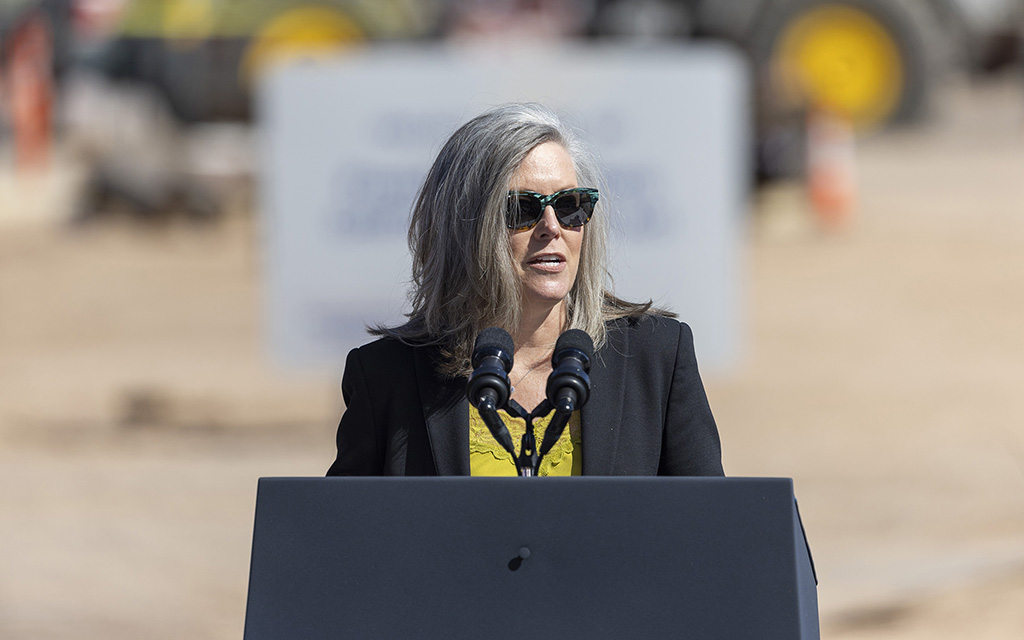
President Joe Biden walks with workers at Intel’s Chandler plant, where he announced an $8.5 billion grant to help the company expand its chipmaking capacity there. (Photo by Sam Ballesteros/Cronkite News)

The Intel chip-making plant in Chandler is just one of the company’s sites that will benefit from the $8.5 billion grant and $11 billion in loans announced by the president Wednesday. (Photo by Sam Ballesteros/Cronkite News)
CHANDLER – President Joe Biden announced the award of $8.5 billion to chipmaker Intel on Wednesday, along with $11 billion in loans that will help the semiconductor manufacturer expand operations in Arizona and three other states.
The grant, the largest to date under the CHIPS and Science Act, will let Intel upgrade current facilities in Chandler and construct what the company says will be two “leading edge” facilities there, making it the largest chipmaking location in the country when it opens in late 2025. The Chandler project is expected to create 3,000 manufacturing jobs along with 7,000 construction jobs.
“It’s not just producing, you know, old stuff,” Intel Chief Operations Officer Keyvan Esfarjani said before Wednesday’s event. “This is producing the leading-edge semiconductor manufacturing in the United States, creating thousands of jobs and, of course, really forging ahead for onshoring manufacturing back in the United States.”
Biden, backed by state and local officials, made the announcement at Intel’s Ocotillo campus. The federal funding, combined with billions that are being invested by Intel, will help expand and build new semiconductor factories in Ohio, Oregon and New Mexico as well as Arizona.
Biden said the investment will “transform the semiconductor industry and create entirely new ecosystems, entirely new research in design and manufacture advanced chips in America.”

Gov. Katie Hobbs said the federal funding for Intel will help Arizona become “the center for made in America semiconductor manufacturing.” (Photo by Sam Ballesteros/Cronkite News)
“Today’s investment helps all Americans, red states and blue states. All across America – urban, rural, suburban and tribal communities. We’re not leaving anyone behind,” said Biden, standing in front of construction equipment and the rising steel frame of a new plant.
The event was part of a three-day swing through Nevada, Arizona and Texas that included several campaign events along with policy announcements.
The U.S. currently makes just 12% of the world’s semiconductor chips, while consuming nearly half of all global production, according to a 2020 Semiconductor Industry Association report.
“We think it’s really important that for advanced node chip manufacturing, we’re able to do that here in the United States using American engineers and American technicians and workers so that we can advance our national security interests,” said Intel Chief People Officer Christy Pambianchi before the announcement.
The Intel grant is part of the $280 billion included in the CHIPS and Science Act. While that 2022 law is aimed at sparking a renewal of U.S. semiconductor manufacturing, a coalition of environmental, labor and advocacy groups is working to make sure that the funds help working families, too.
That coalition, CHIPS Communities United, voiced concerns Wednesday about the potential environmental impacts and labor practices of the Intel deal. It urged Intel to negotiate enforceable contracts “with workers and residents in the communities where they’re planning to build or expand facilities.”
Pambianchi said that Intel has “a longstanding history of working very closely with all the communities within which we operate. We’ve been here in Arizona for over 40 years.”
The coalition also pushed for Intel to commit to sustainable practices for the water-intensive chipmaking process and to “take necessary action to protect the environment and local communities” around its factories.
Esfarjani said the Ocotillo campus recycles all the water used for manufacturing there, and supports water restoration projects elsewhere to create “net positive water” in Arizona. He said the company is proceeding with “the utmost focus on sustainability.”
Also on hand Wednesday were Commerce Secretary Gina Raimondo, Rep. Greg Stanton, D-Phoenix, Phoenix Mayor Kate Gallego and Gila River Indian Community Gov. Stephen Roe Lewis, among others, who all voiced enthusiasm for the project and its future economic impact. Arizona Gov. Katie Hobbs said it “marks another critical investment in the strength and security of our country.”
“As we have shown, Arizona is ready, willing and able to lead the nation in developing cutting-edge technologies, growing businesses and creating jobs, and being the center for made in America semiconductor manufacturing,” Hobbs said.
Chandler Mayor Kevin Hartke said the project adds to the city’s, and the Valley’s, “vast and unique ecosystem of semiconductor manufacturing and technology companies unparalleled by any region in the world.”
“Intel and Chandler here have a 45 year relationship supporting the most complex manufacturing process in the world in a clean, reliable and efficient way,” Hartke said.


